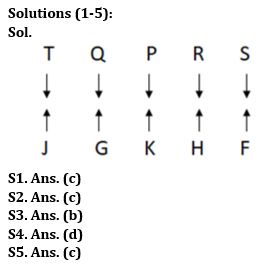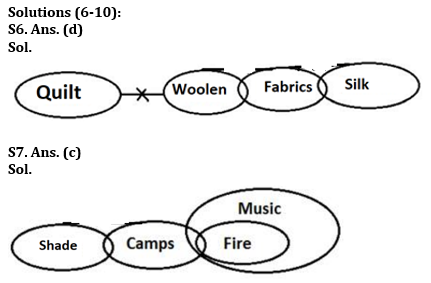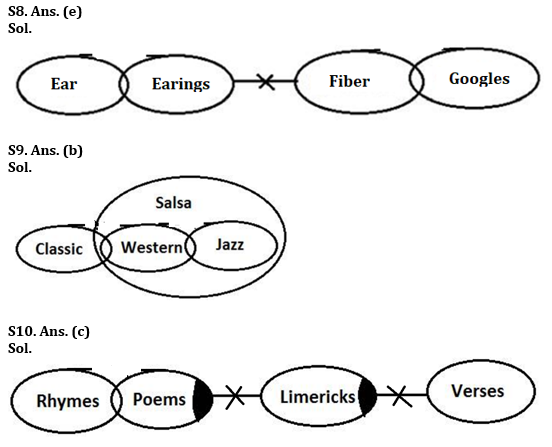Directions (1-5): Study the following information carefully and answer the questions accordingly.
Ten people are sitting in two parallel rows. In Row 1 – P, Q, R, S, and T are sitting facing the south direction and in Row 2 – F, G, H, J, and K are sitting facing the north direction but not necessarily in the same order. The people sit in row 1 are facing the people sit in row 2 and vice versa.
T sits third to the right of R. The one who sits opposite T, sits second to the left of K. F sits to the right of K. Two people sit between F and G who does not sit opposite T. P sits second to the right of S. J does not sit opposite R.
Q1. How many people sit between J and K?
(a) Three
(b) Two
(c) One
(d) Either One or Two
(e) None
Q2. Who among the following sits opposite S?
(a) J
(b) K
(c) F
(d) H
(e) None of these
Q3. Who among the following sits to the right of Q?
(a) R
(b) T
(c) S
(d) P
(e) None of these
Q4. Find the correct statement/statements from the following.
1. H sits to the right of F.
2. P sits opposite G.
3. J sits diagonally opposite S.
(a) Only 2
(b) Both 1 and 3
(c) Both 2 and 3
(d) Only 3
(e) None is incorrect
Q5. Four from the following five are similar in a certain way and thus form a group. Find out the one who does not belong to that group.
(a) T
(b) J
(c) R
(d) F
(e) S
Directions (6-10): In the question below, three statements are given followed by the conclusions. You have to take the given statements to be true even if they seem to be at variance with commonly known facts. Read all the conclusions and then decide which of the given conclusions logically follows from the given statements disregarding commonly known facts.
Q6. Statements: No Quilt are Woolen.
Only a few Woolen are Fabrics.
Only a few Fabrics are Silk.
Conclusions: I. Some Quilt are not Fabrics
II. Some Silk are not Woolen
(a) If only conclusion I follows.
(b) If only conclusion II follows.
(c) If either conclusion I or II follows.
(d) If neither conclusion I nor II follows.
(e) If both conclusions I and II follow.
Q7. Statements: Only a few Shade are Camps.
Some Camps are Fire.
All Fires are Music.
Conclusions: I. All Camps are Fire
II. Some Camps are not Fire.
(a) If only conclusion I follows.
(b) If only conclusion II follows.
(c) If either conclusion I or II follows.
(d) If neither conclusion I nor II follows.
(e) If both conclusions I and II follow.
Q8. Statements: Only a few Ear are Earings.
No Earings are Fiber.
Only a few Fiber are Googles.
Conclusions: I. Some Ear are not Fiber
II. Some Googles are not Earings.
(a) If only conclusion I follows.
(b) If only conclusion II follows.
(c) If either conclusion I or II follows.
(d) If neither conclusion I nor II follows.
(e) If both conclusions I and II follow.
Q9. Statements: Only a few Classic are Western.
Only a few Western are Jazz.
All Western and Jazz are Salsa.
Conclusions: I. Some Jazz are not Classic
II. All Classic can be Salsa.
(a) If only conclusion I follows.
(b) If only conclusion II follows.
(c) If either conclusion I or II follows.
(d) If neither conclusion I nor II follows.
(e) If both conclusions I and II follow.
Q10. Statements: Only a few Rhymes are Poems.
Some Poems are not Limericks.
Some Limericks are not Verses.
Conclusions: I. Some Rhymes are Limericks.
II. No Rhymes are Limericks.
(a) If only conclusion I follows.
(b) If only conclusion II follows.
(c) If either conclusion I or II follows.
(d) If neither conclusion I nor II follows.
(e) If both conclusions I and II follow.
Solutions








 GA Capsule for SBI Clerk Mains 2025, Dow...
GA Capsule for SBI Clerk Mains 2025, Dow...
 The Hindu Review October 2022: Download ...
The Hindu Review October 2022: Download ...
 Important Days in April 2025, List of Na...
Important Days in April 2025, List of Na...




